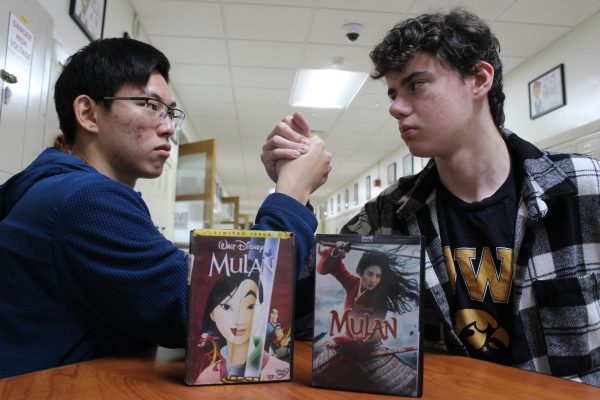“The Mandalorian”: A new frontier for a galaxy far, far away

Courtesy of Walt Disney Pictures
Disney+ launched on Nov. 12 with an abundance of new, original titles. The crown jewel of Disney’s starting lineup of original series is the first live-action Star Wars television show, “The Mandalorian.”
Before the acquisition of Lucasfilm by Disney in 2012, George Lucas had made multiple attempts to launch a Star Wars television show. The closest Lucas came to achieving this goal was the airing of the infamous “Star Wars Holiday Special” in 1978. Negative reception from both fans and critics alike made the likelihood of a high-budget Star Wars television show much slimmer.
But fast forward to 2019 and through the creative minds of writer Jon Favreau (“Iron Man”) and executive producer Dave Filoni (“Star Wars: The Clone Wars”), Disney has successfully released a $120 million live-action Star Wars television show: “The Mandalorian.”
On first viewing, it is apparent that “The Mandalorian” lives up to its massive budget. The production design of the show is a perfect blend of both practical and top-of-the-line CGI effects.
The first episode of “The Mandalorian,” known as “Chapter 1,” aired on Nov. 12. Right off the bat, inspiration from classic Western films gives the show a unique style within the Star Wars canon. Ludwig Gorranson, composer of “Black Panther,” adds to this interesting style by composing a musical score that is a perfect mixture of John Williams’s instantly recognizable original trilogy motifs and musical cues akin to Clint Eastwood’s Western-style films.
Though the episode is strong, the role of the show being a “pilot” — a television term for the first show of a new series — becomes apparent through the extensive world-building of the episode. Yet, the show’s arduous tasks of introducing characters, settings and plot is done in an incredibly effective fashion. The main character of the show, the Mandalorian (Pedro Pascal), is developed mostly through his actions due to his quiet personality. These actions mostly involve the bounty hunter tactics he is willing to use in order to acquire his target for the episode. Since the Mandalorian’s actions drive the story forward, his character development progresses in a natural way without drawing away from the story’s main plot. The unique planets and other settings are also effectively woven into the story in a palatable fashion by providing visual flair and introducing enough unique new aliens species.
The highlight of “Chapter 1” proves to be the show’s final action scene. This scene in particular is well-choreographed while also introducing the fighting limitations of the Mandalorian and bounty hunter robot, IG-88. Lucasfilm can clearly develop traditional Star Wars action scenes for the small screen that have the same quality as those in their feature-length films.
Despite a clear success with the first episode of “The Mandalorian,” the most noticeable flaw of the episode is the directing style. “Chapter 1” is directed by Dave Filoni, a first-time, live-action director for film or television. Filoni’s directing style from animated shows such as “Star Wars: The Clone Wars” was heavily used throughout “Chapter 1.” For example, one scene from the episode intermixes a flashback sequence with shots of the present-day Mandalorian. However, due to the jagged transitions between past and present, it is almost impossible to distinguish what occurs in the flashback sequence. Despite some odd camera choices, the overall quality of the first episode of “The Mandalorian” did not suffer entirely from Filoni’s inexperience in live-action filmmaking. The episode is interesting enough to encourage viewers to watch the second episode of the series.
“Chapter 2” of “The Mandalorian” proved to be superior to the first episode of the series in almost every way. Although the plot of the “Chapter 2” is much simpler than its predecessor, the episode has cleaner action scenes, more characterization of the main protagonist and side characters, and fantastic world-building of the already massive Star Wars universe. The pacing and directorial style are both clean and interesting enough to provide for an optimal viewing experience. This can mostly be attributed to the fact that the director of this episode, Rick Famuyiwa, clearly has a flair for directing. Since every episode of “The Mandalorian” will be filmed by a different director, it will be interesting to see how the style and aesthetic of the show changes over time.
Whereas “Chapter 1” was a mix of both western and Star Wars elements, “Chapter 2” gives a vibe more similar to the original Star Wars trilogy. This may seem like a strange change, but I feel that it is a positive one. The story of “Chapter 2” lends itself incredibly well to a more traditional Star Wars style. In fact, the settings, characters and specific character choices made in “Chapter 2” make this episode feel the most “Star Wars” of any media that the Lucasfilm brand has produced since its acquisition by Disney in 2012.
Disney+ has an early win with “The Mandalorian”: a fun, action-driven adventure that happens to take place in the ever-expanding Star Wars universe. Although the show has yet to take any major bounds in storytelling, it is still a must-watch for Star Wars fans while also giving casual fans enough reasons to enjoy the show’s unique visuals and settings.








![Senior Sam Foster, who plays the alto saxophone on the Jazz Lab Band, waves at the audience after their final piece. “[Jazz is] just something that I enjoy personally, and I wanted to do,” Foster said.](https://www.lhsdoi.com/wp-content/uploads/2024/04/USE4-600x400.jpg)


![For the final piece, a combination of Symphony Orchestra and Wind Ensemble played an extravagant song by Paul Hindemist. Flute soloist Dakota Olson had her moment highlighted within this song. “[My solo] was definitely challenging but it was fun too,” Olson said.](https://www.lhsdoi.com/wp-content/uploads/2024/03/amy-and-joey-shot-600x400.jpg)
![The Bel Canto choir, the junior choir, performs “Ex-Wives” from “SIX.” “We started [preparing], pretty much right after the Holiday concert,” junior Delaney Rybicki said. Caption by Ash Magalhaes](https://www.lhsdoi.com/wp-content/uploads/2024/02/IMG_7696-600x400.jpg)




